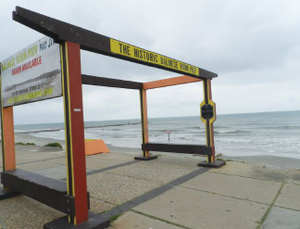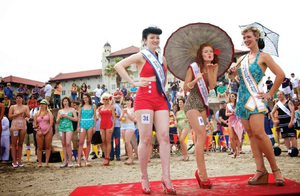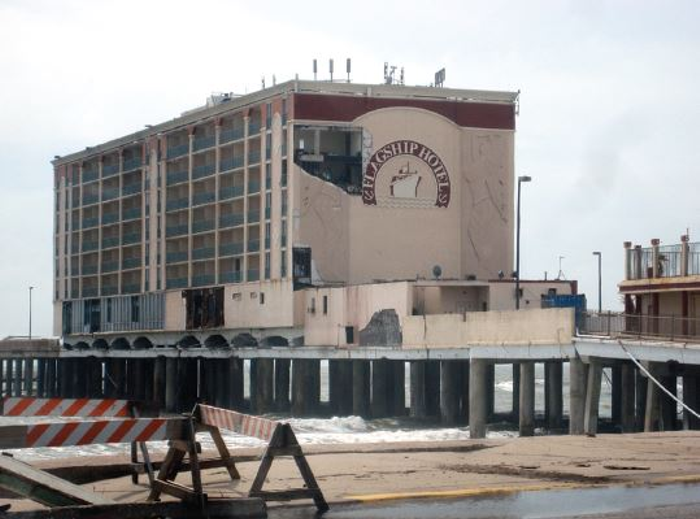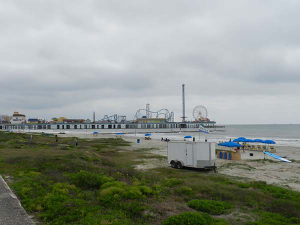Life on the modern day Seawall is boisterous and colorful, teeming with novelty stores, restaurants, hotels, and endless entertainment. Scattered among the throngs of beachside pleasures are the stoic remnants of the Boulevard’s past, the ones who have managed beautifully the passing of the decades and shored up their timeless relevance. The foundation of this multi-faceted personality is an accumulation of all that the Seawall survived and celebrated over the course of a century, but the fervor of its current popularity can also be attributed to the city’s unyielding response in the wake of yet another disaster.The turn of the century followed the slow but steady course of
improvement set forth in the previous decades. The recent happenings served to
heighten the Galveston
community’s sense of awareness of the delicacy of the Seawall’s reputation, and
fortunately it was able to attract a number of entrepreneurs who decided to
capitalize on the need for quality dining and entertainment.
The Spot was sold in 2002, and the new owner was able to transform it
from a bleak undertaking that was losing money every day, to one of the most
sought-after and popular destinations on Seawall Boulevard. Landry’s
Restaurants was now plural, as the company gained a fierce momentum that
catapulted it from a single restaurant to a far-reaching conglomerate. Known
today as Landry’s, Inc., the ubiquitous corporation includes several different
restaurant concepts and hotels, including Seawall hotspots such as the San Luis
Resort, Fish Tales, and Rain Forest Café. They were also responsible for the
removal and demolition of the last of the Seahorse Motor Inn at 3402 Seawall in
2005, a bittersweet event for the community. Many memories remained of when it
introduced beachside luxury to Galveston
in 1956, but it had since become a haven of drugs and prostitution.
On the east end of the Seawall, construction began on a new,
architecturally restricted residential neighborhood called Beachtown in 2006.
The development would eventually be realized as a luxurious collection of
massive, Victorian-style beach houses that energized the historic architectural
template and infused the beachfront with a whimsical charm. Beachtown was also
the precise location where the eye of Hurricane Ike made landfall on September
13, 2008.
At 2:10am, a Category 3 storm with a diameter of 600 miles and peak
winds of 145 miles per hour struck the Island
city. The northern, bay side of the Island was
consumed with a storm surge that measured 13 feet at its highest point, and
along the Seawall monstrous waves toppled over the 17-foot high concrete
barricade. Seawall Boulevard did manage to escape flood damage, but the winds
were merciless. The Island had not witnessed
such destruction since the 1900 Storm.
 Hurricane Ike was the final undoing for the forever-fated Balinese Room,
sending it crumbling into the Gulf of Mexico
along with Murdoch’s, the 100-year old bathhouse turned souvenir store that was
already on its fifth incarnation. The Flagship Hotel, built as a testament of
survival in the wake of Hurricane Carla and a survivor of Hurricane Alicia,
suffered irreparable damage and was permanently closed. The seemingly insurmountable
sidewalk by the sea was strewn with huge piles of debris and resembled a scene
from an apocalyptic movie.
Hurricane Ike was the final undoing for the forever-fated Balinese Room,
sending it crumbling into the Gulf of Mexico
along with Murdoch’s, the 100-year old bathhouse turned souvenir store that was
already on its fifth incarnation. The Flagship Hotel, built as a testament of
survival in the wake of Hurricane Carla and a survivor of Hurricane Alicia,
suffered irreparable damage and was permanently closed. The seemingly insurmountable
sidewalk by the sea was strewn with huge piles of debris and resembled a scene
from an apocalyptic movie.
But as Galveston
had proven time and time again, it was unstoppable. Somewhat disoriented but
otherwise unfazed by the destruction suffered at the hands of Mother Nature,
the Island community rallied once more to convert catastrophe into a catalyst
for progress and creativity. As is typical following a disaster of this
magnitude, many residents left, never to return. But those that remained,
remained undaunted, and the business sector ploughed ahead with a notion to not
only regain but revitalize the attractiveness and allure of Galveston’s Seawall.
 The very next summer a local company called Islander By Choice, LLC,
debuted their annual Galveston Island Beach Revue, a modern tribute to the
original Pageant of Pulchritude that once garnered international acclaim for
the Seawall. Every year on a weekend in May, the Beach Revue ushers in the
summer season and celebrates Galveston’s
heritage with a complete festival featuring a Bathing Beauties Contest, live
music, and vendors.
The very next summer a local company called Islander By Choice, LLC,
debuted their annual Galveston Island Beach Revue, a modern tribute to the
original Pageant of Pulchritude that once garnered international acclaim for
the Seawall. Every year on a weekend in May, the Beach Revue ushers in the
summer season and celebrates Galveston’s
heritage with a complete festival featuring a Bathing Beauties Contest, live
music, and vendors.
Ike barely marked his one year anniversary before Murdoch’s reopened
with a completely new structure. Still family owned after three generations,
the beloved store led the charge and without hesitation rose to become the
city’s beacon of survival. Slowly and deliberately, businesses on the Seawall
followed their lead and either reopened or opened anew.
 However at the intersection of 25th
Street, the haggard remains of the Flagship loomed
over its pier as an inescapable reminder of that September day. In 1990 the
building and operating lease had been taken over by The Flagship Hotel, Ltd.,
who signed a lease with the city through the year 2031, although over the years
several attempts had been made to nullify the lease with accusations that the
hotel was being allowed to fall into severe disrepair.
However at the intersection of 25th
Street, the haggard remains of the Flagship loomed
over its pier as an inescapable reminder of that September day. In 1990 the
building and operating lease had been taken over by The Flagship Hotel, Ltd.,
who signed a lease with the city through the year 2031, although over the years
several attempts had been made to nullify the lease with accusations that the
hotel was being allowed to fall into severe disrepair.
In 2004, Landry’s, Inc. stepped in and purchased the property for
$500,000 and a promise to spend $15 million in renovations, but the lease,
still officially intact, prevented them from moving ahead. The aftermath of
Hurricane Ike revealed that The Flagship Hotel, Ltd. carried only $3 million in
windstorm insurance, far below the lease stipulation that required $10 million.
Landry’s was able to renegotiate the lease and set forth plans for restoring
the hotel.
But in 2010, the company announced that they had changed their plans.
They were not going to restore the hotel. They were going to build an amusement
park instead. An appropriate throwback to the origins of the property as the
Pleasure Pier, Landry’s Inc. announced that the Galveston Island Historic
Pleasure Pier would include full-scale amusement park over the water, complete
with carousel, roller coaster, and Ferris wheel.
 During
the spring of 2011, what remained of the Flagship Hotel was finally demolished,
and as pilings were reinforced and steel was welded into shape, the
construction generated a feverish excitement and ignited a new hope for
Galveston’s future. New businesses arrived steadily in anticipation of more
visitors to the Seawall, and at last the $30 million Pleasure Pier opened to
gasps of amazement in May of 2012.
During
the spring of 2011, what remained of the Flagship Hotel was finally demolished,
and as pilings were reinforced and steel was welded into shape, the
construction generated a feverish excitement and ignited a new hope for
Galveston’s future. New businesses arrived steadily in anticipation of more
visitors to the Seawall, and at last the $30 million Pleasure Pier opened to
gasps of amazement in May of 2012.
That same month, Galveston
residents voted to legitimately implement paid parking along the Seawall for
the first time in its existence, with the idea that the funds would be used to
improve amenities along the beachfront. Recently it was announced that these
amenities, in the form of public restrooms and showers, will finally be realized
by the start of summer 2016, fulfilling a need that has been neglected for nearly fifty years.
Another ongoing project that is nearing completion after many years is
Project SIT, initiated by the local non-profit organization Artist Boat to decorate
the concrete benches that line the sidewalk. Over the past several years
individuals, organizations, and businesses have all contributed to this
beautification project by sponsoring single benches which were adorned with
mosaics of coastal marine life. Recently Project SIT was the beneficiary of a
sponsorship that leaves the project only one bench shy of one hundred percent
completion.
The beaches along the Seawall have also recently received much needed
attention. In May of 2015, it was announced that through the cooperation of the
Galveston Park Board of Trustees, the Texas General Land Office, and the U.S.
Army Corps of Engineers, the beach between 61st and 81st
Streets would be replenished. After years of erosion that rendered sand
practically nonexistent along this stretch, newly dredged sand was brought in
to reconstruct 100 feet of beach between the Seawall and the Gulf, an
achievement that the American
Beach and Shore
Preservation Association named one of the top five beach restorations in the
nation.
July 29, 2016, will mark the 112th anniversary of the
completion of the original Seawall, and over its centennial of existence the
engineering marvel that was once thought of as merely a protector against
destruction and loss of life has become unto the city a lifeblood all of its
own. The Seawall has indeed remained a valiant defense amid a century’s worth
of storms, but its Boulevard has also been a constantly changing, ever
innovating, and always alluring facet of Galveston’s
identity and economy.
In each era that it has existed, the Seawall has morphed to accommodate
the trends, fashions, and cultures of generation after generation. Today, it
triumphantly stands as more than a survivor of storms, but as a window into the
past that illuminates the evolution of societal movement. At the same time, it
plays hosts to hundred-year old businesses that have remained stalwarts of the Island through unprecedented change.
When the roar of the Pleasure Pier roller coaster subsides, you can
still hear the echo of crowds that line the street for the beauty pageant
parades. When the sun fades into the horizon, you can faintly see the sparkling
shadows of Electric
Park. As the surrey bikes
blow past you with the shrill ring of a bell and a screech of delight, you can
sense that all along, the Seawall has known its true purpose.
About
once every twenty years, it goes to work, but for the rest of the time, the
indefatigable sidewalk by the sea plays a most gracious and welcoming host to
families and friends who are in relentless pursuit of fun.